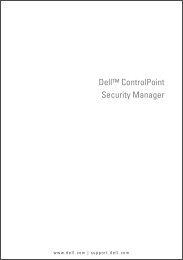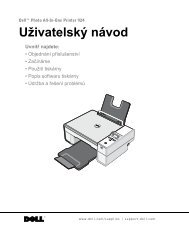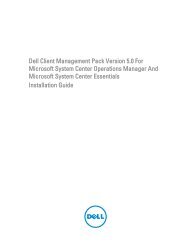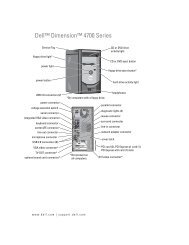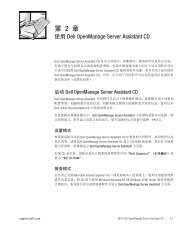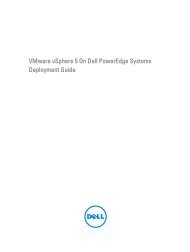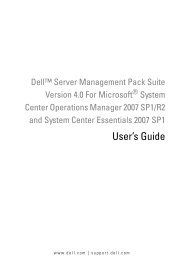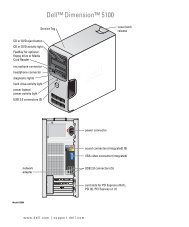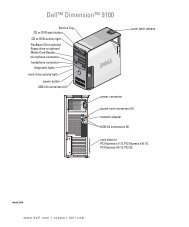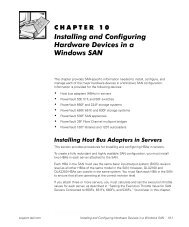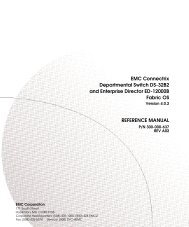Dell OpenManage Server Administrator Version 7.1 ... - Dell Support
Dell OpenManage Server Administrator Version 7.1 ... - Dell Support
Dell OpenManage Server Administrator Version 7.1 ... - Dell Support
You also want an ePaper? Increase the reach of your titles
YUMPU automatically turns print PDFs into web optimized ePapers that Google loves.
Installing Managed System Software on<br />
Microsoft Windows Operating Systems<br />
On Microsoft Windows, an autorun utility is displayed when you insert the <strong>Dell</strong> Systems Management Tools and<br />
Documentation DVD. This utility allows you to choose the systems management software you want to install on the<br />
system.<br />
If the autorun program does not start automatically, use the setup program in the SYSMGMT\srvadmin\windows<br />
directory on the <strong>Dell</strong> Systems Management Tools and Documentation DVD. See the <strong>Dell</strong> Systems Software <strong>Support</strong><br />
Matrix for a list of operating systems currently supported.<br />
NOTE: Use the <strong>Dell</strong> Systems Management Tools and Documentation DVD to perform an unattended and scripted<br />
silent installation of the managed system software. Install and uninstall the features from the command line.<br />
Deployment Scenarios for <strong>Server</strong> <strong>Administrator</strong><br />
You can install <strong>Dell</strong> <strong>OpenManage</strong> <strong>Server</strong> <strong>Administrator</strong> in the following ways:<br />
• Install the <strong>Server</strong> <strong>Administrator</strong> Web <strong>Server</strong> on any system (<strong>Dell</strong> PowerEdge system, laptop, or desktop) and the<br />
<strong>Server</strong> Instrumentation on another supported <strong>Dell</strong> PowerEdge system.<br />
In this method, the <strong>Server</strong> <strong>Administrator</strong> Web <strong>Server</strong> performs the function of a central web server and you can<br />
use it to monitor a number of managed systems. Using this method reduces the <strong>Server</strong> <strong>Administrator</strong> footprint on<br />
the managed systems.<br />
• Continue to install the <strong>Server</strong> <strong>Administrator</strong> Web <strong>Server</strong> and the <strong>Server</strong> Instrumentation on the same system.<br />
The following table lists the deployment scenarios for installing and using <strong>Server</strong> <strong>Administrator</strong> and helps you make the<br />
right choice while selecting the various installation options:<br />
Table 6. Deployment Scenarios<br />
You want to Select<br />
Remotely manage and monitor the entire network of<br />
managed systems from the system (laptop, desktop, or<br />
server).<br />
<strong>Server</strong> <strong>Administrator</strong> Web <strong>Server</strong>. You must then install<br />
<strong>Server</strong> Instrumentation on the managed systems.<br />
Manage and monitor the current system. <strong>Server</strong> <strong>Administrator</strong> Web <strong>Server</strong> and <strong>Server</strong><br />
Instrumentation.<br />
Manage and monitor the current system using some other<br />
remote system.<br />
View the status of local and remote storage attached to a<br />
managed system and obtain storage management<br />
information in an integrated graphical view.<br />
3<br />
Remote Enablement<br />
For systems running on Microsoft Windows, Remote<br />
Enablement is under the <strong>Server</strong> Instrumentation option.<br />
You must then install the <strong>Server</strong> <strong>Administrator</strong> Web <strong>Server</strong><br />
on the remote system.<br />
Storage Management.<br />
29



